
Content
- Steps
- Method 1 of 3: Removing the glass with tweezers
- Method 2 of 3: Caring for the wound after removing the glass
- Method 3 of 3: When to Seek Medical Help
- Warnings
Glass in a wound is very painful and dangerous, as there is a risk of infection if delayed with treatment. In most cases, the glass can be removed from a small wound with tweezers. After removing the glass, clean and care for the wound to reduce the risk of infection. However, in some situations, medical attention may be needed, for example if the glass is deeply stuck in a wound or if there is heavy bleeding. Examine the wound carefully and if in any doubt, be sure to see a doctor.
Steps
Method 1 of 3: Removing the glass with tweezers
 1 Wash your hands and the damaged area with warm water and mild soap. Wet your hands with water and lather for 20 seconds. Then rinse off the soap completely and dry your hands with a clean, dry towel. Then hold the wound under warm (but not hot) running water. Use your fingertips to dab some mild soap around the edges of the wound. Hold the wound under running water again to wash off the soap.
1 Wash your hands and the damaged area with warm water and mild soap. Wet your hands with water and lather for 20 seconds. Then rinse off the soap completely and dry your hands with a clean, dry towel. Then hold the wound under warm (but not hot) running water. Use your fingertips to dab some mild soap around the edges of the wound. Hold the wound under running water again to wash off the soap. - Do not rub the wound, otherwise the glass may penetrate deeper. Just keep it under running water.
- Do not apply soap directly to the wound, as this can irritate. Apply soap only around the edges of the wound.
 2 Dip the tweezers in rubbing alcohol to sterilize it. Pour into a small cup and dip tweezers into it to disinfect it. Make sure that both ends of the tweezers are submerged in the alcohol. You can simply dip the tweezers briefly or leave them in alcohol for a few minutes. Then take out the tweezers and place them on a clean paper towel to dry.
2 Dip the tweezers in rubbing alcohol to sterilize it. Pour into a small cup and dip tweezers into it to disinfect it. Make sure that both ends of the tweezers are submerged in the alcohol. You can simply dip the tweezers briefly or leave them in alcohol for a few minutes. Then take out the tweezers and place them on a clean paper towel to dry. - The alcohol dries quickly, so the tweezers are ready to use a few minutes after you take them out of the cup.
- If you don't have alcohol, you can hold the tweezers in a pot of boiling water for 10 minutes. Then remove the tweezers with tongs and place them on a clean, dry towel to dry.
 3 Grasp the glass with tweezers and pull it out of the wound. Find the end of the glass shard. If it is small, try looking at it with a magnifying glass. After you find the edge of the shard, grab it with tweezers. Pull the shard out of the leather in the same direction it penetrated into it. Do not pull the shard in a different direction, as this may cause additional damage. After you take out the shard, throw it into the trash can.
3 Grasp the glass with tweezers and pull it out of the wound. Find the end of the glass shard. If it is small, try looking at it with a magnifying glass. After you find the edge of the shard, grab it with tweezers. Pull the shard out of the leather in the same direction it penetrated into it. Do not pull the shard in a different direction, as this may cause additional damage. After you take out the shard, throw it into the trash can. - Do not squeeze the glass too hard or it may shatter into smaller pieces.
- You may need to repeat this procedure if several glass shards are stuck in your skin.
Advice: If you have an unsteady hand or cannot easily reach the glass yourself, ask someone to help you.
 4 If the glass is completely immersed in the skin, pierce it sterilized needle. If the shard has completely penetrated your skin, it will be difficult for you to reach it with tweezers. In this case, dip the needle in alcohol to sterilize it. Then, pierce the skin with the tip of the needle where the glass shard penetrated. This will tear the surface of the skin, allowing you to grab the glass with tweezers and pull it out.
4 If the glass is completely immersed in the skin, pierce it sterilized needle. If the shard has completely penetrated your skin, it will be difficult for you to reach it with tweezers. In this case, dip the needle in alcohol to sterilize it. Then, pierce the skin with the tip of the needle where the glass shard penetrated. This will tear the surface of the skin, allowing you to grab the glass with tweezers and pull it out. - Do not try this if the glass has gone too deep. Only pierce the skin with a needle if the shard is just below the surface and covered with a thin layer of skin. If it has penetrated too deep or you cannot easily separate the skin, seek medical attention.
Method 2 of 3: Caring for the wound after removing the glass
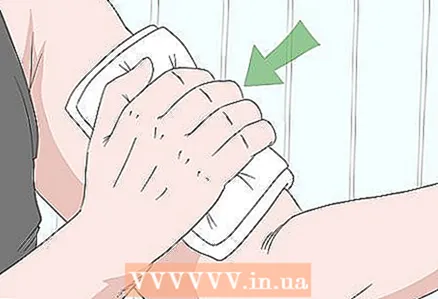 1 Press down on the wound if blood is spurting out of it or it is bleeding heavily. After removing the splinter, press a piece of cotton gauze or a clean, dry towel against the wound. Press the gauze or towel firmly against the wound for 10 minutes. Then remove the gauze and towel and examine the wound. If it still bleeds, press down on it again and seek medical attention.
1 Press down on the wound if blood is spurting out of it or it is bleeding heavily. After removing the splinter, press a piece of cotton gauze or a clean, dry towel against the wound. Press the gauze or towel firmly against the wound for 10 minutes. Then remove the gauze and towel and examine the wound. If it still bleeds, press down on it again and seek medical attention. - If the dressing is completely soaked in blood within one hour, you should also seek medical attention.
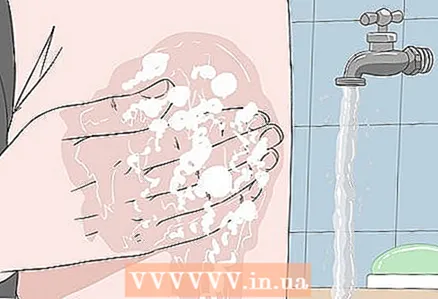 2 Wash the affected area and hands again with warm water and soap. After removing the glass shard, rinse the wound again. Soak the wound under warm, running water, then dab some mild soap around the edges. Wash off the soap completely. Then blot the wound with a clean, dry towel (rag or paper). Then wash your hands with warm water and soap.
2 Wash the affected area and hands again with warm water and soap. After removing the glass shard, rinse the wound again. Soak the wound under warm, running water, then dab some mild soap around the edges. Wash off the soap completely. Then blot the wound with a clean, dry towel (rag or paper). Then wash your hands with warm water and soap. - To count down the time you need to wash your hands, try singing a short song to yourself. This will help you wash your hands properly and remove any dirt from them.
 3 Apply an antibacterial ointment to the wound to protect it from infection. An antibacterial ointment can help prevent infection that can develop after removing the glass from the wound. After washing the wound, use your fingertips to apply a thin layer of antibacterial ointment to it.
3 Apply an antibacterial ointment to the wound to protect it from infection. An antibacterial ointment can help prevent infection that can develop after removing the glass from the wound. After washing the wound, use your fingertips to apply a thin layer of antibacterial ointment to it. - An antibacterial wound ointment can be purchased at your local pharmacy.
 4 Leave the wound open unless irritation or contamination is at risk. If the wound is in a location that does not normally come into contact with clothing or other surfaces, do not cover it. This will speed up healing. However, if the wound is located in a place that often comes into contact with clothing or other objects, such as the foot or palm, it is better to cover it.
4 Leave the wound open unless irritation or contamination is at risk. If the wound is in a location that does not normally come into contact with clothing or other surfaces, do not cover it. This will speed up healing. However, if the wound is located in a place that often comes into contact with clothing or other objects, such as the foot or palm, it is better to cover it. - If you decide to cover the wound, place a bandage large enough to completely cover the damaged area. You can use a piece of gauze, a medical bandage, or an adhesive plaster.
 5 Get a tetanus shot if you haven't had one in the past 5 years or more. A puncture wound can cause tetanus, a serious and life-threatening illness. If you have not had a tetanus shot in the past 5 years, make an appointment with your doctor as soon as possible.
5 Get a tetanus shot if you haven't had one in the past 5 years or more. A puncture wound can cause tetanus, a serious and life-threatening illness. If you have not had a tetanus shot in the past 5 years, make an appointment with your doctor as soon as possible. Advice: Get your vaccinations on time so you don't have to worry too much in case of injury. Get regular checkups and get tetanus shots every 5 years, or as recommended by your doctor.
 6 Watch for signs of possible infection after removing the glass. If you notice any signs of infection after removing the glass from the wound, go to the emergency room immediately. The infection usually develops within a few days after the injury. The following signs indicate infection:
6 Watch for signs of possible infection after removing the glass. If you notice any signs of infection after removing the glass from the wound, go to the emergency room immediately. The infection usually develops within a few days after the injury. The following signs indicate infection: - pus, pain, tenderness, swelling, or redness;
- temperature 38 ° C or higher;
- red streaks extending from the wound.
Method 3 of 3: When to Seek Medical Help
 1 Seek medical attention immediately if glass is dropped on a sensitive area. If the glass has fallen into a delicate or sensitive area on the body, you can seek medical attention to remove it. The doctor will be able to reach the glass safer and with less pain. Seek medical attention if glass falls into any of the following areas:
1 Seek medical attention immediately if glass is dropped on a sensitive area. If the glass has fallen into a delicate or sensitive area on the body, you can seek medical attention to remove it. The doctor will be able to reach the glass safer and with less pain. Seek medical attention if glass falls into any of the following areas: - face, especially eyes;
- neck;
- a joint, such as an arm, wrist, or foot;
- fingernails or toenails.
 2 Go to the emergency room immediately if there is a risk that you have damaged a main artery. If the wound is bleeding in jerks, it could be a sign that one of your major arteries is damaged (depending on the location of the wound). Call 103 (in Russia) immediately or the appropriate emergency number if you are in another country and apply a bandage to the wound.
2 Go to the emergency room immediately if there is a risk that you have damaged a main artery. If the wound is bleeding in jerks, it could be a sign that one of your major arteries is damaged (depending on the location of the wound). Call 103 (in Russia) immediately or the appropriate emergency number if you are in another country and apply a bandage to the wound. - If blood seeps through the bandage, do not remove it. Just put another bandage on top.
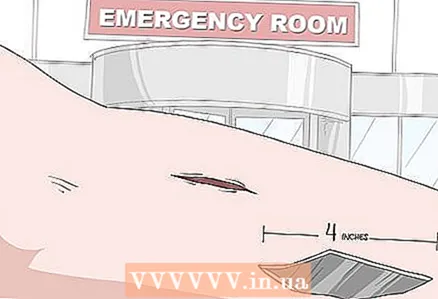 3 Go to the nearest emergency room for other special circumstances. Although a small piece of glass can usually be removed by yourself, some situations require medical attention.Seek medical attention if:
3 Go to the nearest emergency room for other special circumstances. Although a small piece of glass can usually be removed by yourself, some situations require medical attention.Seek medical attention if: - a large shard of glass hit the wound, for example, longer than 10 centimeters;
- the glass has penetrated deep into the skin or muscles;
- the shard is difficult to get;
- you feel numbness in the affected area or in the limb underneath.
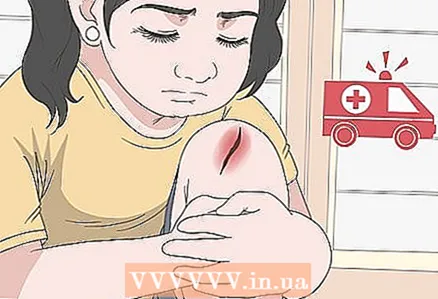 4 If a child is injured by the glass and remains in the wound, go to the emergency room anyway. Children are much less tolerant of pain, so it may be difficult for you to retrieve the shard yourself. In addition, the child may be injured even more when removing the glass. Therefore, the glass must be removed by a doctor or other healthcare professional. To make it safer and easier for your child, seek immediate medical attention.
4 If a child is injured by the glass and remains in the wound, go to the emergency room anyway. Children are much less tolerant of pain, so it may be difficult for you to retrieve the shard yourself. In addition, the child may be injured even more when removing the glass. Therefore, the glass must be removed by a doctor or other healthcare professional. To make it safer and easier for your child, seek immediate medical attention. - The doctor will be able to apply local anesthesia to numb the area where the glass shard is located and painlessly remove the shard.
Advice: On the way to the clinic, make sure that the child does not touch the wound and does not try to get the glass on his own. Try to distract your child with his favorite game, book, toy, or cartoon.
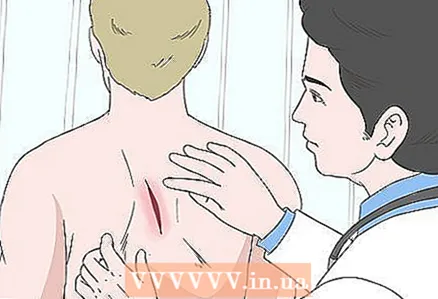 5 See your doctor if you cannot get the glass yourself. Sometimes, when trying to remove glass at home, it can split into smaller fragments inside the skin. In this case, or if you are unable to remove the glass for any other reason, go to the nearest emergency room immediately.
5 See your doctor if you cannot get the glass yourself. Sometimes, when trying to remove glass at home, it can split into smaller fragments inside the skin. In this case, or if you are unable to remove the glass for any other reason, go to the nearest emergency room immediately. - For example, you should seek medical attention if you have removed a few shards from a wound, but small fragments of glass remain in the skin.
 6 Complete imaging studies to locate deeply penetrated glass. In most cases, the glass in the wound is clearly visible and there is no need for any diagnostic studies, but sometimes the glass penetrates so deep that it is not visible on the skin surface. In such cases, ultrasound, computed tomography, or MRI (magnetic resonance imaging) may be required to determine exactly where the fragment is located and what tissues are affected. This will help the doctor choose the best way to remove the glass.
6 Complete imaging studies to locate deeply penetrated glass. In most cases, the glass in the wound is clearly visible and there is no need for any diagnostic studies, but sometimes the glass penetrates so deep that it is not visible on the skin surface. In such cases, ultrasound, computed tomography, or MRI (magnetic resonance imaging) may be required to determine exactly where the fragment is located and what tissues are affected. This will help the doctor choose the best way to remove the glass. - If a large piece of glass has penetrated deep into the wound, a CT scan or MRI may also be needed to determine if it has damaged bones, nerves, or blood vessels.
- An x-ray may also be needed to determine the exact location of the glass before removing it.
 7 If the glass has penetrated too deep, it may be surgically removed. In some cases, surgery may be required to remove the shrapnel from the wound (for example, if it has penetrated deep into the skin or muscles). The surgeon may make an incision where the glass has entered to make it easier to reach it. He may also use a surgical clamp to spread tissue as needed and grab the glass with tweezers. The surgeon then stops the bleeding and stitches the wound.
7 If the glass has penetrated too deep, it may be surgically removed. In some cases, surgery may be required to remove the shrapnel from the wound (for example, if it has penetrated deep into the skin or muscles). The surgeon may make an incision where the glass has entered to make it easier to reach it. He may also use a surgical clamp to spread tissue as needed and grab the glass with tweezers. The surgeon then stops the bleeding and stitches the wound. - The surgery uses local or general anesthesia so that you don't feel anything during the procedure.
Warnings
- Do not apply antiseptic solutions such as hydrogen peroxide or iodine to wounds. They have been shown to slow down wound healing.



